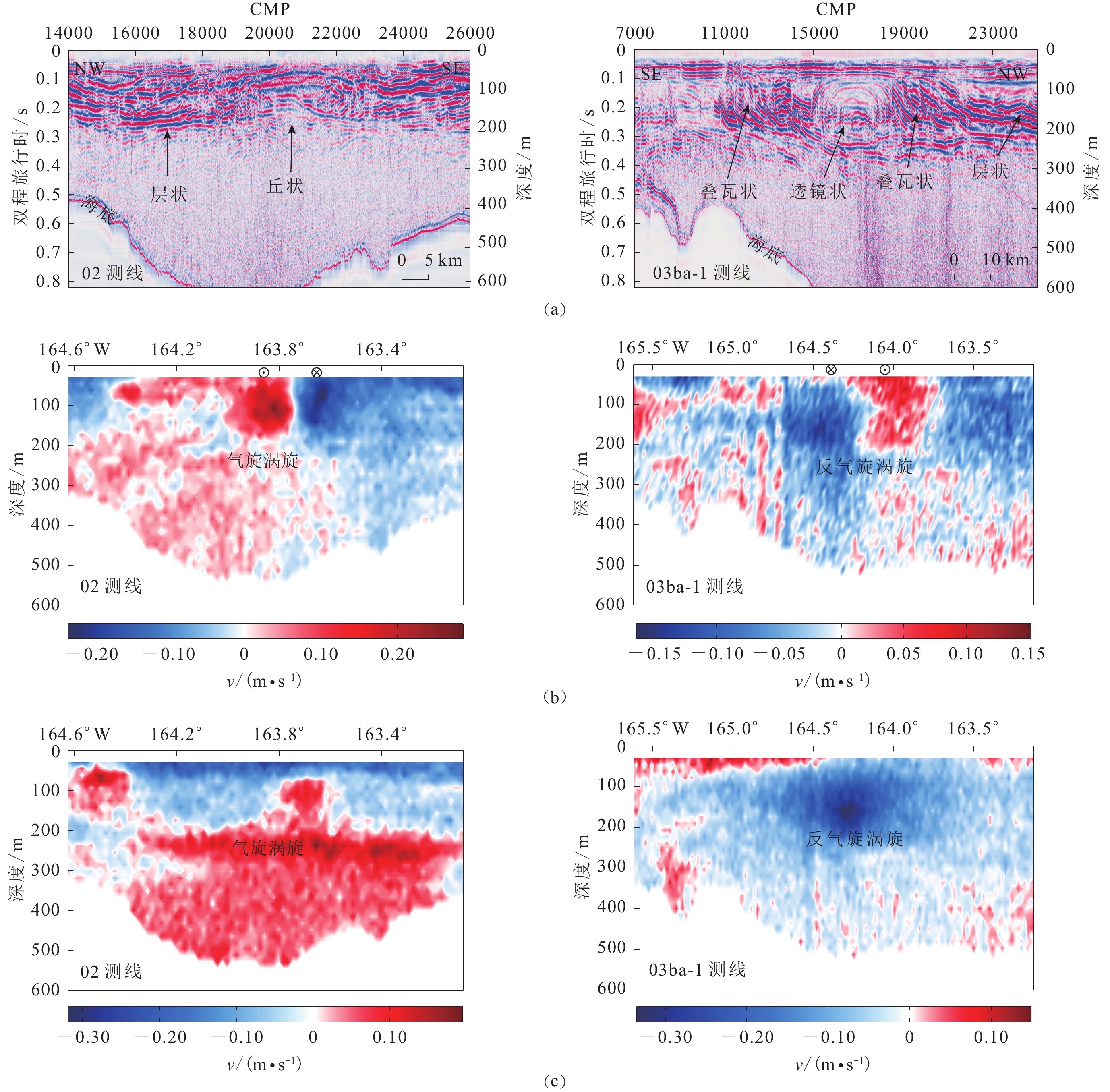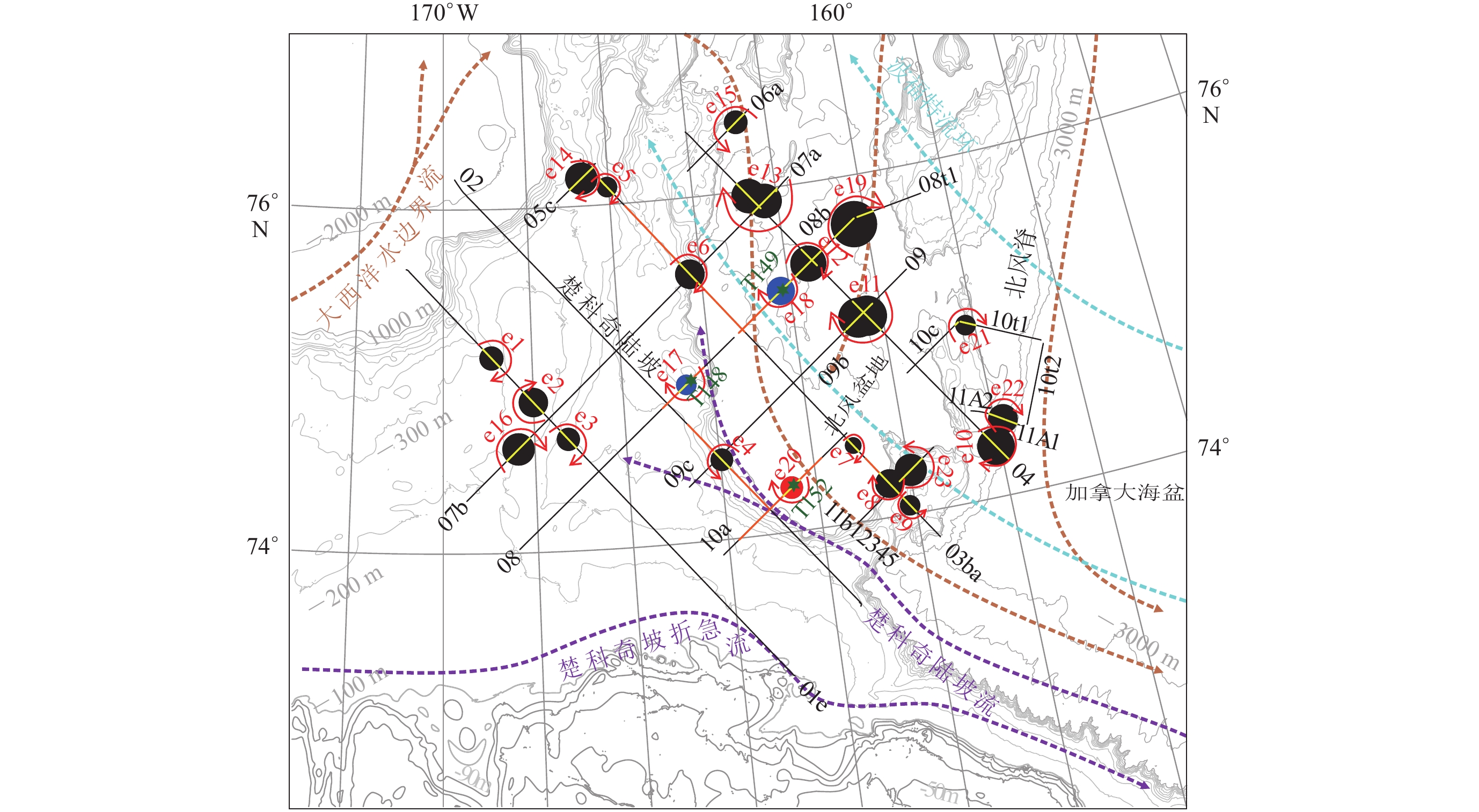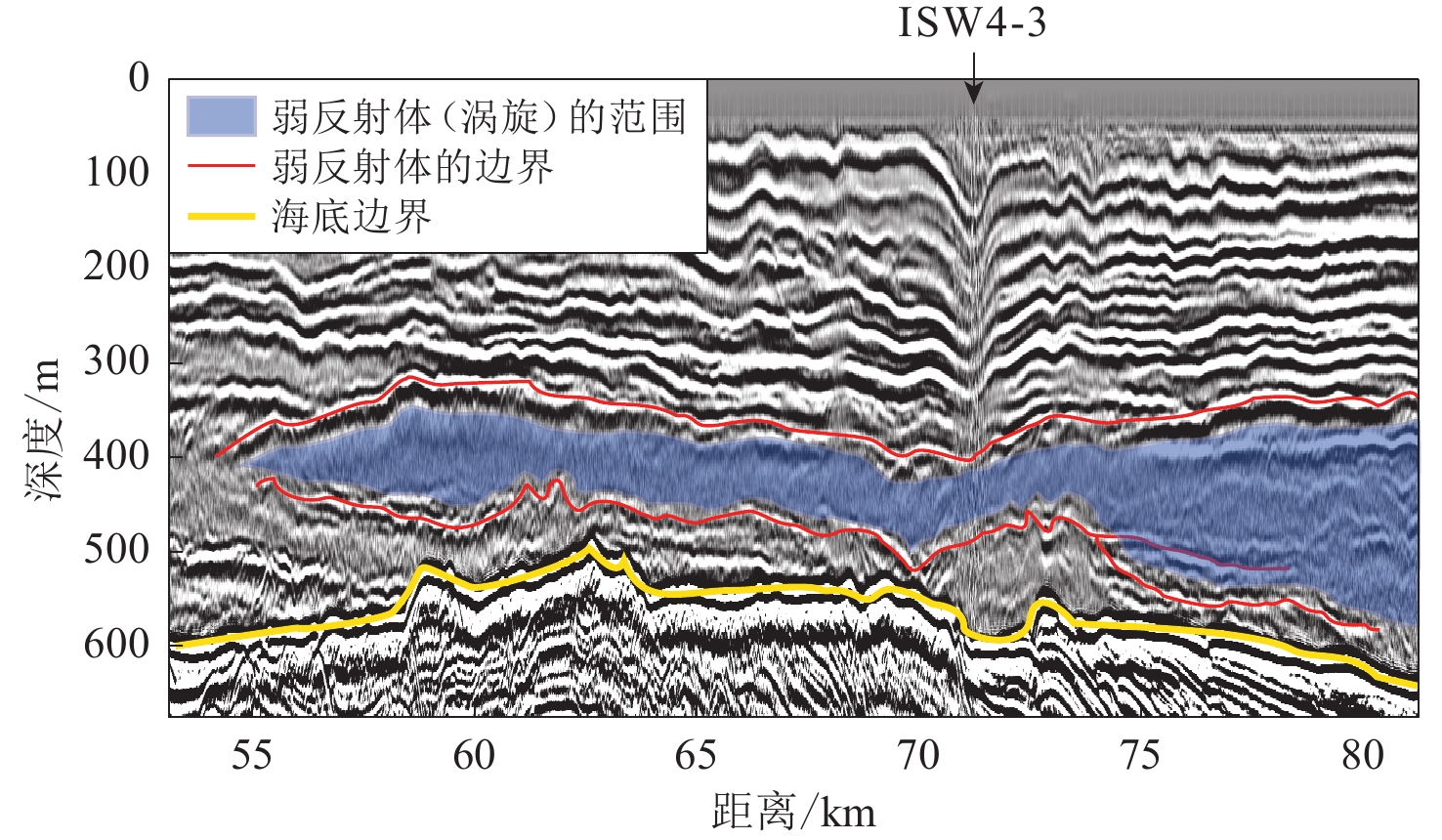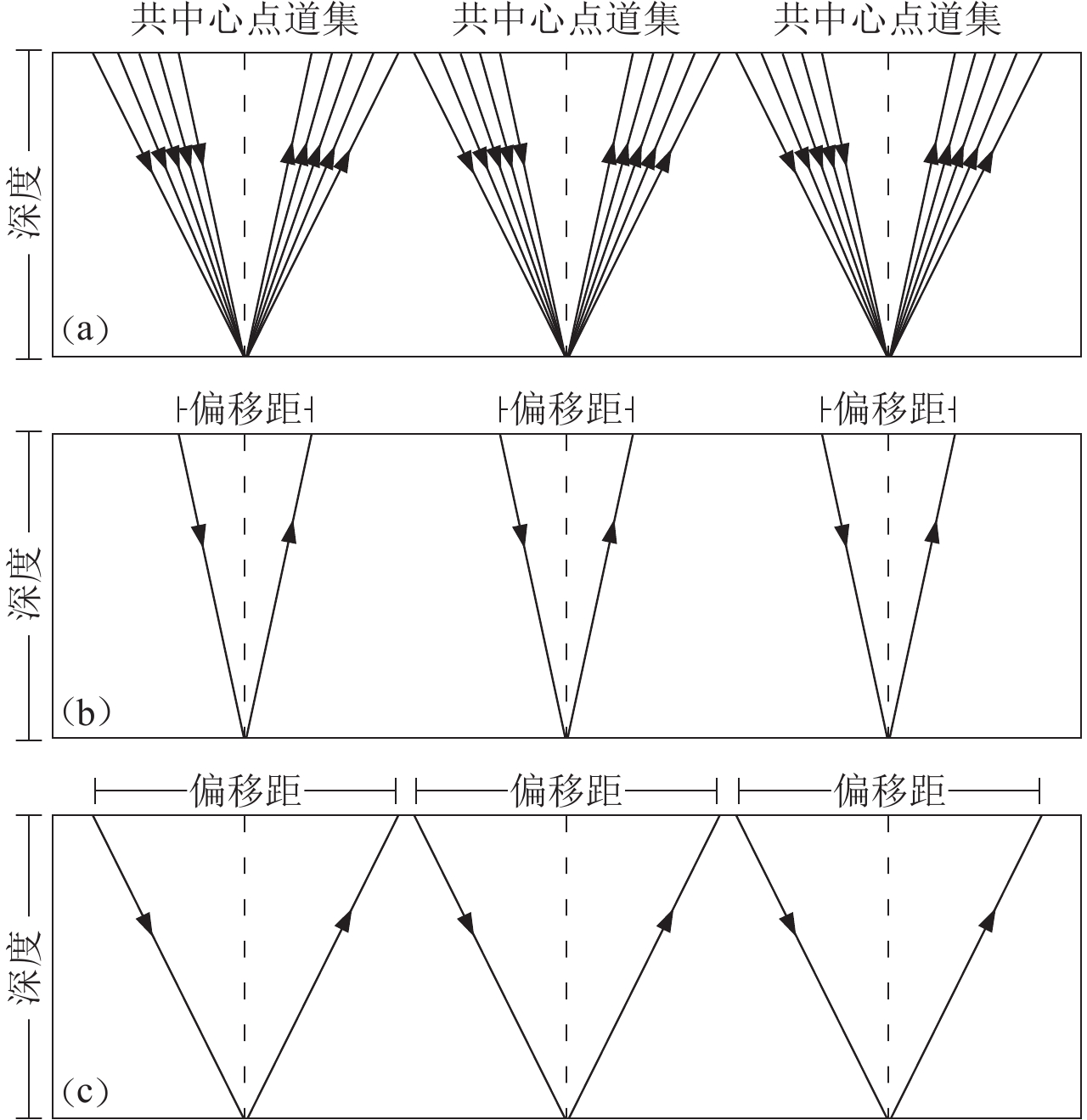New progress in seismic oceanography
-
摘要: 多尺度动力过程是当前海洋学研究的重点。地震海洋学能在数百km的剖面上获得分辨率为10 m的高质量数据,基于该数据能够解析涡旋边缘的亚中尺度动力现象(如北冰洋地震剖面研究发现的漂亮旋臂)和内孤立波的振幅垂向结构,并能够进行内孤立波波形变化与混合参数分布叠合分析等,本文对这些方面获得的新认识和新进展进行了综述。同时,共偏移距剖面叠前偏移方法充分利用多道地震的多次覆盖特点,获得随时间变化的一系列地震图像,为地震海洋学在海洋内部结构的时空演变研究方面增添了利器。因此,地震海洋学提供的新的时空视角必将在海洋多尺度动力过程研究中起到重要作用。
-
关键词:
- 地震海洋学 /
- 涡旋 /
- 内孤立波 /
- 多尺度动力过程 /
- 共偏移距剖面叠前偏移
Abstract: Ocean multi-scale dynamic processes are the focus of current oceanography research. Seismic oceanography can obtain high-quality data with a resolution of 10 m on hundreds of km section, so it can analyze the sub-mesoscale dynamic phenomenon at the edge of an eddy (such as the beautiful spiral arm found in the Arctic Ocean seismic section study) and the vertical amplitude structure of the internal solitary waves, and can combine the internal solitary wave waveform change with the mixing parameter distribution. This paper reviews the new insights and advances of these studies. At the same time, the common offset section prestack migration method makes full use of the multiple coverage characteristics of multi-channel seismic method to obtain the temporal variation of seismic images, thus adding a key tool for seismic oceanography to reveal the spatio-temporal evolution of the ocean internal structure. Therefore, the new space-time perspective provided by seismic oceanography will play an important role in the study of ocean multi-scale dynamic processes. -
-
图 1 同步采集的地震和流速剖面上的气旋涡旋(左)和反气旋涡旋(右)(引自 Zhang et al,2022)
(a) 02测线和03ba-1测线的地震图像;(b) 02测线和03ba-1测线的垂直断面流速,图中正值(红色)表示海流从页面向内,负值(蓝色)表示海流向外;(c) 02号测线和03ba-1号测线沿断面流速,图中正值(红色)表示海流向左,负值(蓝色)表示海流向右
Figure 1. Cyclonic eddy (left) and anticlonic eddy (right) shown on the seismic images,perpendicular section component and along section component of water current velocity from acoustic Doppler current profilers (ADCP) (after Zhang et al,2022)
(a) Seismic images of lines 02 and 03ba-1;(b) Perpendicular section component of water current velocity of lines 02 and 03ba-1,where a positive value (in red color) indicates the current is inward from the page,and a negative value (in blue color) is outward;(c) Along section component of water current velocity of lines 02 and 03ba-1,where a positive value (in red color) in the along section component indicates the current is leftward,and a negative value (in blue color) is rightward
图 2 利用反射地震与水文同步观测资料揭示的北冰洋楚科奇海域涡旋分布(引自Zhang et al,2022)
黑色实线表示地震测量剖面;黄色实线显示了地震剖面上涡核部分的范围;实心圆表示估计的涡核分布范围,其中黑色实心圆表示涡旋的位置,红色实心圆表示暖水核涡旋,两个蓝色实心圆表示冷水核涡旋;红色弯曲箭头表示气旋和反气旋的旋转方向;绿色星号表示抛弃式温度剖面仪(XBT)测量站的位置
Figure 2. The distribution of eddies in the Chukotka Sea in the Arctic Ocean (after Zhang et al,2022)
Solid black lines indicate the seismic survey lines. Solid yellow lines show the range of the eddy core part on the seismic images. The circles with different colors indicate the estimated range of the eddy core. Black circles show the locations of eddies. The red circle indicates a warm-core eddy and two blue circles indicate cold-core eddies. Cyclonic and anti-cyclonic can be read from the red curving arrows. The green star indicates the location of expendable-bathythermograph (XBT) stations
图 3 不同尺度背景的螺旋涡(引自Yang et al,2022b)
(a) 2003年9月4日在冰岛附近观测到的热带气旋中分辨率成像光谱仪(MODIS)图像(https://en.wikipedia.org/wiki/Cyclone),图中螺旋状的白云为螺旋雨带;(b) 2020年8月15日Landsat 8卫星采集的波罗的海蓝藻海表图像(https://oceancolor.gsfc.nasa.gov/gallery/717/),描绘了瑞典哥特兰岛周围有害藻类的泛滥,显示了海洋涡旋的海表特征
Figure 3. Spiral bands of vortex phenomena in different scales (after Yang et al,2022b)
(a) A moderate resolution imaging spectroradiometer (MODIS) image (from https://en.wikipedia.org/wiki/Cyclone) of an extratropical cyclone near Iceland observed on 4 September 2003,where spiral white clouds are rain bands;(b) Baltic cyanobacteria from Landsat 8. The image (from https://oceancolor.gsfc.nasa.gov/gallery/717/) was collected on 15 August 2020,and depicts surface slicks of the harmful algal bloom around the Swedish island of Gotland
图 4 涡旋的反射地震图像(引自Yang et al,2022b)
(a) L04测线和L09/09b测线,图上方向右箭头表示调查船行进方向,下图中间的空白带是由于地震采集中断而造成,右下角为反射同相轴的参考角度;(b) 涡旋核心深度处(159 m)的ADCP流速矢量(黑色箭头),图中黄色圆圈为推测的涡旋核心边界,黄点为涡旋中心位置,左下角的标尺指示1 m/s的参考速度。从速度方向推断,L09/09b线采集时的涡旋真实中心位于航迹上确定的涡旋中心的西部
Figure 4. Seismic images of the big eddy (after Yang et al,2022)
(a) Line L04 and line L09/09b. The rightward arrow above indicates the vessel direction. The gap in the middle of lower panel is due to the interruption of the seismic acquisition. The reference angles of the reflections are displayed in the lower right corner;(b) Horizontal current velocities (black arrows) at a depth of 159 m (about the core depth) measured with an ADCP. The arrow in the lower left corner is the reference velocity of 1 m/s. The real center (yellow dot) when line L09/09b acquisition,inferred from the velocity directions,is located in the west of the eddy center in the track. The two yellow circles are the inferred eddy core boundaries
图 5 利用反射地震与水文同步观测资料揭示的北冰洋楚科奇海域涡旋漂亮的旋臂结构(Yang et al,2022b),图中箭头指向涡旋螺旋臂的水平位置
(a) L04测线(图4a)的两段剖面;(b) L09/09b测线(图4b)的两段剖面
Figure 5. The beautiful spiral arm structure of an eddy in the Chukchi sea area of the Arctic ocean revealed by simultaneous observations of reflection seismic and hydrological data (Yang et al,2022b). The downward arrows point to the horizontal positions of the eddy’s inferred spiral arms
(a) Part sections of Line 04 shown in Fig. 4a;(b) Part sections of Line 09/09b shown in Fig. 4b
图 6 内孤立波ISW1-2 (a),ISW2 (b)和ISW5-1 (c)的地震剖面(左)和垂向结构(右)(引自Gong et al,2021a)
Figure 6. The seismic sections (left panels) and vertical structures (right panels) of ISW1-2 (a),ISW2 (b) and ISW5-1 (c)(after Gong et al,2021a)
图 7 内孤立波ISW3 (a)和ISW5-2 (b)的地震剖面(左)和垂向结构(右)(引自Gong et al,2021a)
Figure 7. The seismic sections (left panels) and vertical structures (right panels) of ISW3 (a) and ISW5-2 (b)(after Gong et al,2021a)
图 9 测线L1 (a),L2 (b)和L3 (c)中的扩散率$ {K}_{\rho } $剖面(引自Gong et al,2021b)。图中黑色箭头表示抽取扩散率垂直分布曲线的位置
Figure 9. The diapycnal diffusivity $ {K}_{\rho } $ map of survey lines L1 (a),L2 (b) and L3 (c)(after Gong et al,2021b). The black arrows represent the position of vertical diffusivity profile
图 11 不同偏移距的共偏移距道集(COG)偏移剖面(引自Song et al,2021b)
棕色区域代表海底地形。地震剖面以彩色显示,通过追踪红色同相轴来研究内孤立波波形
Figure 11. COG migrated sections with different offsets (after Song et al,2021b)
The brown areas represent seafloor topography. Seismic section was displayed in color,and red events are traced to study internal solitary wave waveforms
-
拜阳, 宋海斌, 关永贤, 杨胜雄, 刘伯然, 陈江欣, 耿明会. 2015. 利用地震海洋学方法研究南海东北部东沙海域内孤立波的结构特征[J]. 科学通报, 60(10): 944-951. Bai Y, Song H B, Guan Y X, Yang S X, Liu B R, Chen J X, Geng M H. 2015. Nonlinear internal solitary waves in the northeast South China Sea near Dongsha Atoll using seismic oceanography[J]. Chinese Science Bulletin, 60(10): 944-951 (in Chinese). doi: 10.1360/N972014-00911
范文豪, 宋海斌, 龚屹, 张锟, 孙绍箐. 2021. 中美洲海域第二模态内孤立波的地震海洋学研究[J]. 地球物理学报, 64(1): 195-208. Fan W H, Song H B, Gong Y, Zhang K, Sun S Q. 2021. Seismic oceanography study of mode-2 internal solitary waves offshore Central America[J]. Chinese Journal of Geophysics (in Chinese), 64(1): 195-208 (in Chinese).
邝芸艳, 王亚龙, 宋海斌, 关永贤, 范文豪, 龚屹, 张锟. 2021. 南海东北部内孤立波包的地震海洋学和遥感研究[J]. 地球物理学报, 64(2): 597-611. Kuang Y Y, Wang Y L, Song H B, Guan Y Y, Fan W H, Gong Y, Zhang K. 2021. Study of internal solitary wave packets in the northeastern South China Sea based on seismic oceanography and remote sensing[J]. Chinese Journal of Geophysics (in Chinese), 64(2): 597-611 (in Chinese).
梁智超, 宋海斌, 范文豪, 杨顺. 2022. 加利福尼亚海湾及其邻近海域亚中尺度现象的地震海洋学研究[J]. 地球物理学报, 65(8): 3040-3053. Liang Z C, Song H B, Fan W H, Yang S. 2022. Seismic oceanography research of submesoscale phenomena in the Gulf of California and its adjacent regions[J]. Chinese Journal of Geophysics, 65(8): 3040-3053 (in Chinese).
南峰, 于非, 徐安琪, 丁雅楠. 2022. 西北太平洋次表层中尺度涡研究进展和展望[J]. 地球科学进展, 37(11): 1115-1126. Nan F, Yu F, Xu A Q, Ding Y N. 2022. Progress and prospect of subsurface-intensified eddies in the northwestern Pacific Ocean[J]. Advances in Earth Science, 37(11): 1115-1126 (in Chinese).
宋海斌. 2012. 地震海洋学导论[M]. 上海: 上海科学技术出版社: 1–182. Song H B. 2012. Introduction to Seismic Oceanography[M]. Shanghai: Shanghai Scientific and Technical Publishers: 1–182 (in Chinese).
杨顺, 宋海斌, 范文豪, 吴迪. 2021. 中美洲鹦鹉湾气旋涡的亚中尺度结构特征[J]. 地球物理学报, 64(4): 1328-1340 doi: 10.6038/cjg2021O0204 Yang S, Song H B, Fan W H, Wu D. 2021. Submesoscale features of a cyclonic eddy in the Gulf of Papagayo, Central America[J]. Chinese Journal of Geophysics (in Chinese), 64(4): 1328-1340 (in Chinese). doi: 10.6038/cjg2021O0204
Alford M H, Peacock T, Mackinnon J A, Nash J D, Buijsman M C, Centurioni L R, Chao S Y, Chang M H, Farmer D M, Fringer O B, Fu K H, Gallacher P C, Graber H C, Helfrich K R, Jachec S M, Jackson C R, Klymak J M, Ko D S, Jan S, Johnston T M S, Legg S, Lee I H, Lien R C, Mercier M J, Moum J N, Musgrave R, Park J H, Pickering A I, Pinkel R, Rainville L, Ramp S R, Rudnick D L, Sarkar S, Scotti A, Simmons H L, St Laurent L C, Venayagamoorthy S K, Wang Y H, Wang J, Yang Y J, Paluszkiewicz T, Tang T Y. 2015. The formation and fate of internal waves in the South China Sea[J]. Nature, 521(7550): 65-69. doi: 10.1038/nature14399
Bai Y, Song H B, Guan Y X, Yang S X. 2017. Estimating depth of polarity conversion of shoaling internal solitary waves in the northeastern South China Sea[J]. Cont Shelf Res, 143: 9-17. doi: 10.1016/j.csr.2017.05.014
Buffett G G, Krahmann G, Klaeschen D, Schroeder K, Sallarès V, Papenberg C, Ranero C R, Zitellini N. 2017. Seismic Oceanography in the Tyrrhenian Sea: Thermohaline staircases, eddies, and internal waves[J]. J Geophys Res: Oceans, 122(11): 8503-8523. doi: 10.1002/2017JC012726
Cai S Q, Xie J S, He J L. 2012. An overview of internal solitary waves in the South China Sea[J]. Surv Geophys, 33(5): 927-943. doi: 10.1007/s10712-012-9176-0
Dickinson A, White N J, Caulfield C P. 2017. Spatial variation of diapycnal diffusivity estimated from seismic imaging of internal wave field, Gulf of Mexico[J]. J Geophys Res: Oceans, 122(12): 9827-9854. doi: 10.1002/2017JC013352
Dickinson A, Gunn K L. 2022. The next decade of seismic oceanography: Possibilities, challenges and solutions[J]. Front Mar Sci, 9: 736693. doi: 10.3389/fmars.2022.736693
Fan W H, Song H B, Gong Y, Sun S Q, Zhang K, Wu D, Kuang Y Y, Yang S. 2021. The shoaling mode-2 internal solitary waves in the Pacific coast of Central America investigated by marine seismic survey data[J]. Cont Shelf Res, 212: 104318. doi: 10.1016/j.csr.2020.104318
Fan W H, Song H B, Gong Y, Yang S, Zhang K. 2022. Regional study of mode-2 internal solitary waves at the Pacific coast of Central America using marine seismic survey data[J]. Nonlin Processes Geophys, 29(2): 141-160. doi: 10.5194/npg-29-141-2022
Fu K H, Wang Y H, St. Laurent L, Simmons H L, Wang D P. 2012. Shoaling of large-amplitude nonlinear internal waves at Dongsha Atoll in the northern South China Sea[J]. Cont Shelf Res, 37: 1-7. doi: 10.1016/j.csr.2012.01.010.
Geng M H, Song H B, Guan Y X, Bai Y. 2019. Analyzing amplitudes of internal solitary waves in the northern South China Sea by use of seismic oceanography data[J]. Deep Sea Res Part I: Oceanogr Res Pap, 146: 1−10.
Gong Y, Song H B, Zhao Z X, Guan Y X, Kuang Y Y. 2021a. On the vertical structure of internal solitary waves in the northeastern South China Sea[J]. Deep Sea Res Part I: Oceanogr Res Pap, 173: 103550.
Gong Y, Song H B, Zhao Z X, Guan Y X, Zhang K, Kuang Y Y, Fan W H. 2021b. Enhanced diapycnal mixing with polarity-reversing internal solitary waves revealed by seismic reflection data[J]. Nonlin Processes Geophys, 28(3): 445-465. doi: 10.5194/npg-28-445-2021
Gorman A R, Smillie M W, Cooper J K, Bowman M H, Vennell R, Holbrook W S, Frew R. 2018. Seismic characterization of oceanic water masses, water mass boundaries, and mesoscale eddies SE of New Zealand[J]. J Geophys Res: Oceans, 123(2): 1519-1532. doi: 10.1002/2017JC013459
Gunn K L, White N J, Larter R D, Caulfield C P. 2018. Calibrated seismic imaging of eddy-dominated warm-water transport across the Bellingshausen Sea, Southern Ocean[J]. J Geophys Res: Oceans, 123(4): 3072-3099. doi: 10.1029/2018JC013833
Gunn K L, White N, Caulfield C C P. 2020. Time-lapse seismic imaging of oceanic fronts and transient lenses within south Atlantic Ocean[J]. J Geophys Res: Oceans, 125(7): e2020JC016293.
Gunn K L, Dickinson A, White N J, Caulfield C C P. 2021. Vertical mixing and heat fluxes conditioned by a seismically imaged oceanic front[J]. Front Mar Sci, 8: 697179. doi: 10.3389/fmars.2021.697179
Holbrook W S, Páramo P, Pearse S, Schmitt R W. 2003. Thermohaline fine structure in an oceanographic front from seismic reflection profiling[J]. Science, 301(5634): 821-824. doi: 10.1126/science.1085116
Lamb K G. 2014. Internal wave breaking and dissipation mechanisms on the continental slope/shelf[J]. Annu Rev Fluid Mech, 46(1): 231-254. doi: 10.1146/annurev-fluid-011212-140701
Liu A K, Chang Y S, Hsu M K, Liang N K. 1998. Evolution of nonlinear internal waves in the East and South China Seas[J]. J Geophys Res: Oceans, 103(C4): 7995-8008. doi: 10.1029/97JC01918
Nakamura Y, Noguchi T, Tsuji T, Itoh S, Niino H, Matsuoka T. 2006. Simultaneous seismic reflection and physical oceanographic observations of oceanic fine structure in the Kuroshio extension front[J]. Geophys Res Lett, 33(23): L23605. doi: 10.1029/2006GL027437
Papenberg C, Klaeschen D, Krahmann G, Hobbs R W. 2010. Ocean temperature and salinity inverted from combined hydrographic and seismic data[J]. Geophys Res Lett, 37(4): L04601.
Pinheiro L M, Song H B, Ruddick B, Dubert J, Ambar I, Mustafa K, Bezerra R. 2010. Detailed 2-D imaging of the Mediterranean outflow and meddies off W Iberia from multichannel seismic data[J]. J Mar Syst, 79(1/2): 89-100.
Ruddick B, Song H B, Dong C Z, Pinheiro L. 2009. Water column seismic images as maps of temperature gradient[J]. Oceanography, 22(1): 192-205. doi: 10.5670/oceanog.2009.19
Sheen K L, White N J, Hobbs R W. 2009. Estimating mixing rates from seismic images of oceanic structure[J]. Geophys Res Lett, 36(24): L00D04.
Song H B, Pinheiro L M, Ruddick B, Teixeira F C. 2011. Meddy, spiral arms, and mixing mechanisms viewed by seismic imaging in the Tagus Abyssal Plain (SW Iberia) [J]. J Mar Res, 69(4/5/6): 827-842. https: //doi.org/10.1357/002224011799849309
Song H B, Chen J X, Pinheiro L M, Ruddick B, Fan W H, Gong Y, Zhang K. 2021a. Progress and prospects of seismic oceanography[J]. Deep Sea Res Part I: Oceanogr Res Pap, 177: 103631.
Song H B, Gong Y, Yang S X, Guan Y X. 2021b. Observations of internal structure changes in shoaling internal solitary waves based on seismic oceanography method[J]. Front Mar Sci, 8: 733959. doi: 10.3389/fmars.2021.733959
Tang Q S, Wang C X, Wang D X, Pawlowicz R. 2014. Seismic, satellite and site observations of internal solitary waves in the NE South China Sea[J]. Sci Rep, 4: 5374. doi: 10.1038/srep05374
Tang Q S, Hobbs R, Wang D X, Sun L T, Zheng C, Li J B, Dong C Z. 2015. Marine seismic observation of internal solitary wave packets in the northeast South China Sea[J]. J Geophys Res: Oceans, 120(12): 8487-8503. doi: 10.1002/2015JC011362
Tang Q S, Gulick S P S, Sun J, Sun L T, Jing Z Y. 2020. Submesoscale features and turbulent mixing of an oblique anticyclonic eddy in the Gulf of Alaska Investigated by Marine Seismic Survey Data[J]. J Geophys Res: Oceans, 125(1): e2019JC015393.
Xiao W X, Sheen K L, Tang Q S, Shutler J, Hobbs R, Ehmen T. 2021. Temperature and salinity inverted for a Mediterranean Eddy captured with seismic data, using a spatially iterative Markov Chain Monte Carlo approach[J]. Front Mar Sci, 8: 734125. doi: 10.3389/fmars.2021.734125
Yang S, Song H B, Zhang K. 2022a. Research on submesoscale eddy and front near the South Shetland Islands (Antarctic Peninsula) using seismic oceanography data[J]. Adv Polar Sci, 33(1): 110-118.
Yang S, Song H B, Coakley B, Zhang K, Fan W H. 2022b. A mesoscale eddy with submesoscale spiral bands observed from seismic reflection sections in the Northwind Basin, Arctic Ocean[J]. J Geophys Res: Oceans, 127(3): e2021JC017984. doi: 10.1029/2021JC017984
Zhang K, Song H B, Coakley B, Yang S, Fan W H. 2022. Investigating eddies from coincident seismic and hydrographic measurements in the Chukchi Borderlands, the western Arctic Ocean[J]. J Geophys Res: Oceans, 127(10): e2022JC018453.





 下载:
下载:










